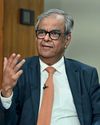
On November 29, immediately after the National Statistical Office (NSO) came out with the second-quarter GDP growth numbers – 4.5 per cent, a six-year low – the government went into damage control. Atanu Chakraborty, Secretary, Department of Economic Affairs, and K. Subramanian, Chief Economic Advisor, addressed a hurriedly called media briefing.
The government’s usual comforting words were that the fundamentals of the economy are still strong, growth has bottomed out and that the growth rate from the next quarter would improve. A day before the second-quarter numbers were announced, Nirmala Sitharaman told the Rajya Sabha that “if you are looking at the economy with a discerning view, you see that the growth may have come down but it is not a recession yet or it won’t be a recession ever.”
While technical differences between a slowdown and a recession are debatable, the fact that the growth of nominal GDP (measure of goods and services produced at current prices) has fallen sharply to 6.1 per cent in the second quarter, from the Budget target of 12 per cent, should worry the government and people at large.
Even on the real GDP front, if government consumption – which showed a 15 per cent jump in the second quarter and more or less supported overall growth – is taken out of the equation, the situation looks even worse. “For some time there was support from some sectors that are cycle independent like agriculture and government spending. The ex-agriculture and ex-government spending numbers indicate a core trend in the economy which is worse. It is not even 4.5 per cent,” says Siddhartha Sanyal, Chief Economist and Head of Research, Bandhan Bank.
This story is from the December 29, 2019 edition of Business Today.
Start your 7-day Magzter GOLD free trial to access thousands of curated premium stories, and 9,000+ magazines and newspapers.
Already a subscriber ? Sign In
This story is from the December 29, 2019 edition of Business Today.
Start your 7-day Magzter GOLD free trial to access thousands of curated premium stories, and 9,000+ magazines and newspapers.
Already a subscriber? Sign In

"Inaction is worse than mistakes"
What was the problem you were grappling with?

TEEING OFF WITH TITANS
BUSINESS TODAY GOLF RESUMES ITS STORIED JOURNEY WITH THE 2024-25 SEASON OPENER IN DELHI-NCR. THERE ARE SIX MORE CITIES TO COME

AI FOOT FORWARD
THE WHO'S WHO OF THE AI WORLD GATHERED AT THE TAJ MAHAL PALACE IN MUMBAI TO DELIBERATE THE TRANSFORMATIVE IMPACT OF AI ON INNOVATION, INDUSTRIES, AND EVERYDAY LIFE.

Decolonising the Walls
ART START-UP MAAZI MERCHANT IS ON A MISSION TO BRING INDIA'S FORGOTTEN ART BACK HOME

"I'm bringing Kotak under one narrative, one strategy, one umbrella”
Ashok Vaswani is a global banker who spent most of his career overseas at institutions like Citi Group and Barclays, among others.

CHOOSING THE CHAMPIONS
The insights and methodology behind the BT-KPMG India's Best Banks and NBFCs Survey 2023-24.

'INDIA IS AT AN EXTREMELY SWEET SPOT'
The jury members of the BT-KPMG Survey of India's Best Banks and NBFCs discuss developments in the banking sector and more

FROM CRISIS TO TRIUMPH
Dinesh Kumar Khara stewarded SBI through multiple challenges during his tenure, while ensuring that profits tripled, productivity soared, and the bank consolidated its global standing

AT A CROSSROADS
BANKS ARE FACING CHALLENGES ON BOTH SIDES OF THE BALANCE SHEET-ASSETS AS WELL AS LIABILITIES-WHICH ARE PUTTING PRESSURE ON MARGINS.

EXPANSIVE VISION
Bajaj Finance, an outlier in terms of digitisation, faces stiff competition. But it continues to expand its reach